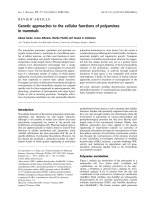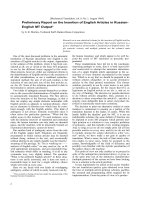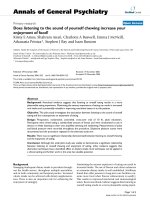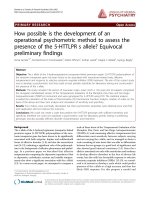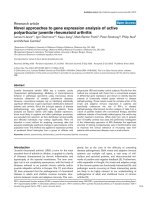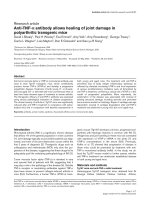Báo cáo y học: " New approaches to the modulation of inflammatory processes in airway disease models" pdf
Bạn đang xem bản rút gọn của tài liệu. Xem và tải ngay bản đầy đủ của tài liệu tại đây (45.66 KB, 4 trang )
commentary review
reports
research article
1
COPD = chronic obstructive pulmonary disease; LPS = lipopolysaccharide; TNF-α = tumour necrosis factor-α.
Available online />Introduction
The American Thoracic Society meeting is the largest
gathering of lung related specialists in the world. Approxi-
mately 16,000 people from 79 different countries
attended the San Francisco meeting. The meeting was
aimed at physicians, scientists and health care providers
and offered up-to-date information on clinical practice and
clinical and basic research. Among the topics covered
were lung injury, asthma, allergy, chronic obstructive pul-
monary disease (COPD), lung development, lung trans-
plantation and gene expression in a programme containing
more than 300 scientific and clinical symposia. Presenta-
Meeting report
New approaches to the modulation of inflammatory processes in
airway disease models: ATS 2001, May 18–23, San Francisco
David J Hele
Respiratory Pharmacology Group, Cardiothoracic Surgery, Imperial College School of Medicine, National Heart and Lung Institute, London, UK
Correspondence: David J Hele, Respiratory Pharmacology Group, Cardiothoracic Surgery, Imperial College School of Medicine, National Heart and
Lung Institute, Dovehouse Street, London, SW3 6LY, UK. Tel: +44 (0)207 352 8121 Ext. 3042; fax: 0207-351-8126; e-mail:
Abstract
The 97
th
American Thoracic Society meeting proved to be an excellent meeting, providing a wealth of
new information on inflammatory diseases of the airways. Once again there appeared to be an
increased emphasis on chronic obstructive pulmonary disease (COPD) with most of the major drug
companies concentrating a large part of their efforts in this field. An assessment of the new British
Thoracic Society guidelines, which are designed to promote better management of COPD, was also
presented at the meeting. Potential new treatments for inflammatory diseases of the airways including
COPD were described, ranging from phase III trial data with GlaxoSmithKline’s PDE4 inhibitor,
Cilomilast (Ariflo
®
) to the development of AstraZeneca’s novel dual dopamine D
2
-receptor/
β
2
-adrenoreceptor agonist, Viozan™. Of particular interest was Byk Gulden’s Ciclesonide, a new
corticosteroid with equivalent efficacy to the market leaders but with an improved safety profile. The
same company also presented data on their PDE4 inhibitor, Roflumilast, which is now in phase II/III.
Bayer presented data on their PDE4 inhibitor, BAY 19-8004, in a smoking animal model and claimed
greater anti-inflammatory efficacy than with a steroid. Asta Medica (now known as Elbion) also
described a new potent PDE4 inhibitor, AWD 12-281, with anti-inflammatory activity. In the
bronchodilator field, an analysis of data from a one-year trial with Boehringer Ingelheim’s Tiotropium
revealed a possible improvement in lung function in COPD patients; this needs to be confirmed in a
specifically designed study. Inhibitors of p38 (c-Jun NH
2
-terminal kinase and syk kinase) were also
discussed as anti-inflammatory agents with potential in the treatment of COPD and asthma.
GlaxoSmithKline’s p38 kinase inhibitor, SB 239063, appeared to be the most advanced of these with
clinical data expected in two to three years. Lyn kinase was also discussed as a novel target for
inflammatory airway diseases.
Keywords: airway diseases, animal models, chronic obstructive pulmonary disease, new approaches, new
treatments
Received: 1 June 2001
Revisions requested: 13 June 2001
Revisions received: 13 June 2001
Accepted: 14 June 2001
Published: 3 July 2001
Respir Res 2001, 2:E003
This article may contain supplementary data which can only be found
online at />© 2001 BioMed Central Ltd
(Print ISSN 1465-9921; Online ISSN 1465-993X)
2
Respiratory Research Vol 2 No 5 Hele
tions of original research in all respiratory fields are always
a highlight of the meeting.
Review
Dr D Halpin and Dr M Rudolf (The Royal Devon and Exeter
Hospital, Exeter, Devon, UK) on behalf of the British Tho-
racic Society COPD consortium presented an assess-
ment of the new British Thoracic Society guidelines, which
are designed to promote better management of COPD. It
showed that in terms of therapy, the use of long-acting β
2
-
adrenergic bronchodilators and anticholinergics is still
increasing, whereas steroid use has not increased since
1997. The use of spirometry in diagnosis has increased
but is still much underused and advice on smoking cessa-
tion or its therapy does not appear to be widely available
to patients.
New approaches
MA Birrell (Imperial College, London, UK) described a
murine model of lipopolysaccharide (LPS)-induced neu-
trophilic airway inflammation. He showed that the mouse
has distinct advantages over the rat in that it provides the
opportunity to dissect the mechanisms involved in inflam-
matory responses using the molecular (transgenic and
gene knockout animals) and immunological (antibodies)
tools, which are more readily available for the mouse than
rat. To further explore the advantages conferred by using
mice the same author also described the development
and partial characterisation of a model of elastase-induced
emphysema in the mouse. This model may be of great use
to the many groups now seeking to study and develop
drugs for the treatment of COPD.
Dr DC Underwood (GlaxoSmithKline, Philadelphia, USA)
described a short-term murine model of smoke inhalation
and outlined its use in the study of smoking-related inflam-
mation. Mice were exposed to smoke for one to three days
and the inflammatory response was studied. First he
demonstrated the development of an inflammatory
response and then showed that the resulting inflammation
could be inhibited by pretreatment with the selective p38
MAP kinase inhibitor, SB 239063. The data support the
use of this type of compound for the future treatment of
inflammatory lung diseases such as COPD.
New treatments
Corticosteroids
Two posters, which generated a lot of interest, described
preclinical studies with Ciclesonide, a new corticosteroid.
Dr M Belvisi (Imperial College, London, UK) outlined in
vivo data in the Brown Norway rat supporting the concept
that Ciclesonide is a prodrug, which when delivered
directly into the airways, can be transformed by esterase
cleavage into the active metabolite (R-M1) producing high
local anti-inflammatory activity. The anti-inflammatory effi-
cacy of Ciclesonide in these studies was similar to that
produced by Fluticasone but with an improved safety
profile, thus demonstrating an improved therapeutic ratio
over Fluticasone. These findings were supported by the
findings of Dr D Bundschuh (Byk Gulden, Konstanz,
Germany) who, in a range of in vitro and in vivo studies,
demonstrated an improved safety margin with Ciclesonide
when compared to Budesonide. He also demonstrated
the prodrug anti-inflammatory activity of Ciclesonide at the
target organ. Ciclesonide represents a corticosteroid with
an improved safety profile when compared to other corti-
costeroids currently used in the treatment of inflammatory
diseases of the airways. A compound with this profile has
great potential and its future development will be watched
with interest.
D
2
-receptor and
β
2
-adrenoreceptor agonist
Viozan™ (AR-68397AA), a novel dual dopamine D
2
-recep-
tor/β
2
-adrenoreceptor agonist, is being developed as a
potential treatment for COPD. Dr A Young (AstraZeneca,
Loughborough, UK) described work in vitro in guinea pig
trachea and in vivo in the dog, demonstrating rapid onset
and long duration of action of the compound at both the
D
2
and β
2
receptors. Two other presentations examined
the component properties of Viozan™. Dr I Oakley
(AstraZeneca, Loughborough, UK), using the D
2
-selective
agonist AR-C65116AB and the β
2
-adrenoceptor agonist
salbutamol, demonstrated in ovalbumin-sensitised Brown
Norway rats that the D
2
receptor agonist reduced tachy-
pnoea, whereas the β
2
-receptor agonist improved lung
function without affecting respiratory rate. This suggests
the combination of the two agonistic properties may
provide greater benefit than either agonist in isolation.
Dr M Trevisiani (University of Ferrara, Italy) described
studies using a guinea pig spinal cord preparation and
capsaicin-induced plasma leakage in rat trachea. He
showed that the D
2
-receptor agonists ropinirole and AR-
C65116AB inhibit both central and peripheral neuropep-
tide release, providing further evidence of the potential
beneficial effects of these type of compounds in the treat-
ment of inflammatory diseases of the airways.
Anticholinergics
In two poster presentations Dr A Anzueto (University of
Texas, San Antonio, USA) and Dr DP Tashken (University of
California, Los Angeles, USA) presented results of an analy-
sis of two large one year clinical trials with the anticholiner-
gic bronchodilator, Tiotropium, given by inhalation at 18 µg
once daily to patients with COPD. One-year studies of
Tiotropium demonstrated a sustained bronchodilator effect,
reduction in exacerbation frequency and improvement in
quality of life measures. The post hoc analyses suggest that
the rate of lung function loss observed in placebo-treated
patients might be mitigated in Tiotropium-treated patients,
although such an effect of Tiotropium would require a
specifically designed prospective trial.
commentary review
reports
research article
3
PDE4 antagonists
Results from a six-month phase III trial with the novel selec-
tive PDE4 antagonist Cilomilast (Ariflo
®
) in stable COPD
patients were reported at the meeting. Placebo or Cilomilast
at 15 mg orally, twice daily, for 6 months was administered
to a total of 2058 patients. Dr JD Edelson (GlaxoSmithKline,
Philadelphia, USA) demonstrated a sustained improvement
in lung function in COPD patients after treatment with
Cilomilast, and a reduction in the risk of exacerbations. The
same author using the St. Georges Respiratory Question-
naire (a questionnaire used to assess quality of life) also
reported an improvement in health status in the Cilomilast
treated group. Dr CH Compton (GlaxoSmithKline, Philadel-
phia, USA) demonstrated that the compound was safe and
well tolerated in this large patient group. Gastrointestinal
side effects in Cilomilast treated patients were generally
self-limited and mild to moderate in intensity. In a separate
study in the clinic, Dr J Kelly (GlaxoSmithKline, UK) looked
at the possibility of interaction between Cilomilast and theo-
phylline and found no evidence of pharmacokinetic or
dynamic interaction and no cardiovascular interaction.
In a study using human bronchial epithelial and sputum
cells, Dr G Chipappara (Institute of Respiratory Patho-
physiology, Italina national Research Council, Palermo,
Italy) demonstrated a reduction in the neutrophil chemoat-
tractants tumour necrosis factor-α (TNF-α), interleukin-8
and granulocyte-macrophage colony stimulating factor in
cells treated with Cilomilast. This suggests that at least
part of the efficacy of Cilomilast in treating COPD patients
may rest with its ability to reduce neutrophilic inflamma-
tion. Dr CA Owen (University of Utah, USA) demonstrated
that Cilomilast inhibits the migration of activated neu-
trophils and reduces their capacity to mediate extracellular
proteolysis. These effects also support the use of the
compound in the treatment of COPD.
A new addition to the PDE4 inhibitor field is Roflumilast, a
potent and selective compound from Byk Gulden. Dr D
Bundschuh (Byk Gulden, Konstanz, Germany) presented
data in antigen-driven or LPS-driven rat airway inflamma-
tion models. These studies showed that Roflumilast is
much more potent than Cilomilast at reducing cell infiltra-
tion, total protein and TNF-α concentration in bronchoalve-
olar fluid after antigen challenge, and some 310-fold more
potent than Cilomilast in inhibiting LPS-induced circulating
TNF-α. These data were supported by studies conducted
by Dr L Wollin (Byk Gulden, Konstanz, Germany) and Dr
HG Hoymann (Fraunhofer Institute of Toxicology and
Aerosol Research, Hanover, Germany) who demonstrated
a reduction in airway hyperresponsiveness after pretreat-
ment with Roflumilast in an antigen-induced airway hyper-
responsiveness model in the rat. These data suggest that
Roflumilast may provide a potential new candidate for the
treatment of chronic inflammatory disorders of the airways
such as asthma and COPD.
Dr MF Fitzgerald (Bayer, Stoke Poges, UK) described
work with a PDE4 inhibitor, BAY 19-8004, currently in
phase II for asthma and COPD treatment. In an acute cig-
arette smoke exposure model in the guinea pig, BAY
19-8004 showed greater efficacy in reducing the resulting
inflammation than the steroid, betamethasone. These data
suggest the model may be useful for the evaluation of
alternative inflammatory concepts for the treatment of
COPD.
Dr H Poppe (Elbion, Dresden, Germany) described one
further PDE4 antagonist, AWD 12-281, employing a dif-
ferent angle of attack by looking at the effect of the com-
pound on mucus secretion in the mouse and LPS-induced
neutrophilia in the rat and domestic pig. In COPD in man,
bronchioles are filled with viscous mucus produced by
goblet cells. Secretion of serous mucus containing
lysozyme is beneficial in dissolving mucus plugs. AWD
12-281 increased the secretion of serous mucus in mouse
trachea as well as reducing LPS-induced neutrophilia in
rats and pigs.
Kinase inhibitors
In a session on the role of protein kinases in airway inflam-
matory diseases several speakers discussed target identi-
fication, validation and the profiling of novel small molecule
inhibitors in animal models. Dr DW Hay (GlaxoSmithKline,
USA) outlined work with the p38 kinase inhibitor, SB
239063, in models that represent different pathological
aspects of COPD. This compound reduced neutrophil
infiltration, reduced inflammatory cytokine production
(such as interleukin-6) and reduced matrix metallopro-
teinase-9 activity thus supporting the therapeutic potential
of SB 239063 in the treatment of COPD. Dr Hay stated
that the compound should be in the clinic within two to
three years.
Dr GP Anderson (University of Melbourne, Australia) dis-
cussed lyn tyrosine kinase as a possible target for inter-
vention in the treatment of asthma. lyn kinase has been
shown to be a signal transduction intermediate involved in
the production of various cytokines and although not
present in T cells it has been shown to regulate the inflam-
matory response and the influx of T cells. Also, animals
deficient in lyn kinase as a result of homozygous knockout
have been shown to have an enhanced response to
antigen challenge. This evidence supports lyn kinase as a
possible target in the treatment of asthma.
Dr AJ Lewis (Signal, San Diego, USA) presented data with
the c-Jun NH
2
-terminal kinase antagonist, SP 600125.
This compound is selective for c-Jun NH
2
-terminal kinase
1, 2 and 3 but is not orally available and is being tested as
a proof of concept molecule. It showed good anti-inflam-
matory activity in a range of in vitro and in vivo screens
and is being followed up with a new lead compound, SPC
Available online />4
105, which has a good pharmacokinetic profile, is
selective and orally active and may be useful in the treat-
ment of inflammatory diseases of the airways. Dr C Walker
(Novartis, UK) rounded off the session with a talk on two
undisclosed syk kinase inhibitors, again with a good anti-
inflammatory profile aimed more at asthma than COPD.
Conclusion
It was evident from this meeting that a great deal of effort
is going into research on the inflammatory aspects of dis-
eases of the airways and that the greater part of that effort
may now be directed towards potential treatments for
COPD. New animal models, which may be of great benefit
to study the mechanisms involved in the development of
COPD, were described. Many of the major drug compa-
nies are looking for compounds that will modulate the
inflammatory response. The new developments showing
some promise are the steroid with an improved safety
profile (Ciclesonide), the PDE4 inhibitors (such as Cilomi-
last and Roflumilast), compounds that modify cytokine
signal transduction via a specific kinase inhibitor and
Viozan™, which provides a novel approach by combining
β
2
-adrenoreceptor agonist activity with dopamine D
2
-
receptor agonist activity to produce a long acting drug
which is a bronchodilator and inhibits neuroinflammatory
peptide release. One other approach showing some
promise is the use of the long acting anticholinergic,
Tiotropium, which may slow the progressive decline in
lung function that occurs with COPD. This observation,
however, needs to be confirmed in a specifically designed
study. In conclusion the American Thoracic Society
meeting was again very successful, providing plenty of
food for thought for both scientists and clinicians.
Respiratory Research Vol 2 No 5 Hele

